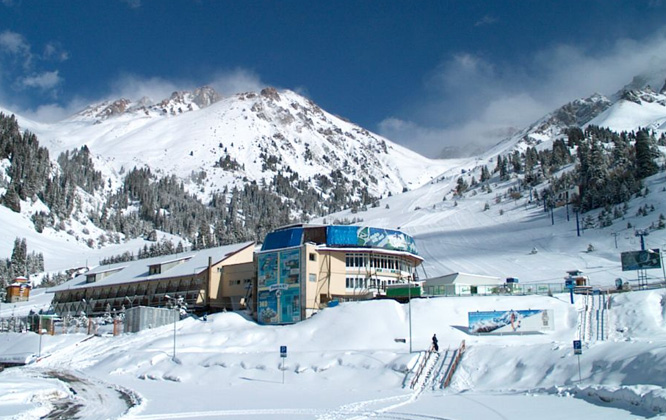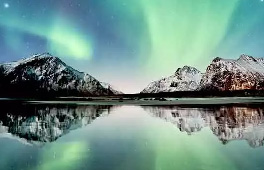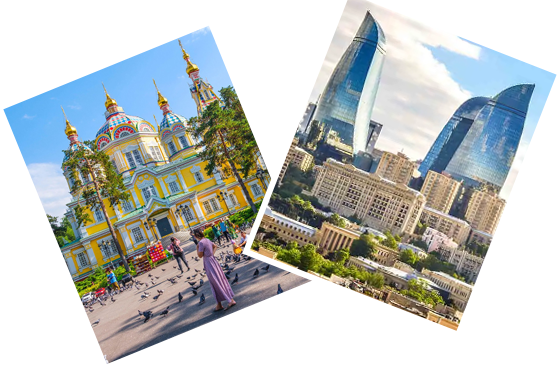A mystical land of enormous deserts, glitzy cities, holy sites, grand souks, and mighty rivers, the Middle East is one epic cradle of civilizations. A complicated yet hospitable land, the Middle East is much more than what we associate it with today. Here history is entrenched into the land rather than being recorded in books – from the stones of the Egyptian pyramids to the expertly carved rocks of Petra and ancient Roman roadstones littered around the region. If human history did not originate here, human civilization certainly did. The earliest known human societies and civilizations cropped up around the area known as the Fertile Crescent, which is covered by modern-day Iraq, Syria, Jordan, and Israel-Palestine. The ancient Mesopotamian civilization first developed the concept of a ‘country’ or a ‘society’ between the rivers Tigris and Euphrates in what today is Iraq.
The Cradle of Civilizations
The Middle East is where human civilization began. The Sumerians established Mesopotamia, the first-ever recorded human society in the world. Since then the region was under the control of the Greeks, Romans, Egyptians, Persians, and the Byzantines till the Islamic Caliphate established their firm dominance in the Arabian peninsula in the late 7th century AD and started spreading around Egypt and Northern Africa. Following the death of Mohammed and the ousting of the Rashidun Caliphate, the Golden Age of Islam kicked off under the Abbasids in Baghdad, sparking a revolution of culture, science, philosophy, and global exchange of ideas that would have seemed impossible even 50 years ago. The human footprint in the region is evident among the many Greco, Roman, Egyptian and Persian ruins such as Persepolis, Petra, Babbel, and the ancient still inhabited cities of Jerusalem and Bethlehem. The Suez Canal and the natural Strait of Hormuz also serve as a testament to Ottoman and European dominance and geopolitics.
Today, even though the Middle East remains one of the most complicated and intolerant regions in the world, it is making strides to accommodate both tradition and modernity in an effort to lure lucrative tourism opportunities. Glitzy cities such as Dubai, Muscat, and Abu Dhabi have become hubs of business and cosmopolitanism, much like the time when the spice routes passed through here. The endless empty desert landscapes and the fascinating Arab culture draw millions of awe-struck travelers from around the world.
A Realm of Natural Wonders
In the midst of the endless deserts, we associate with the Middle East lies a plethora of natural wonders that will dazzle any seasoned traveler. From the vast dunes of the Empty Quarter and the Sahara to the mountains of Hajar, the Jebel Shams, and the deepest saline lake in the world, the Middle East is a delectable concoction of natural splendors. You can go from the lowest point of Earth near the Dead Sea to the bluest waters of the Red Sea, the hottest deserts of the Wahiba Sands to cascading springs of Babab e-Surt and Pamukkale. The first human societies cropped up on the banks of the mighty rivers that cut through the region, namely the Euphrates and the Nile. Surreal landscapes such as the storybook spires of Cappadocia, the Martian landscapes of the Wadi Rum, and the kaleidoscopic caves of the Jeita Grotto enhance the mysticism of the region.
This diversity of landscapes offer some of the wildest adventures travelers could hope for. From spending nights out in the cold desert under the stars true Arabian-Nights style to sandboarding on the massive dunes of the Arabian desert, from diving 18th and 19th-century wrecks in the Red Sea to hot air ballooning over the majestic landscapes of Cappadocia at sunset, there are no limits to the intrepid experiences in the Middle East.
A Land of Hospitality
Despite the common perspectives of the Middle East, the land is home to extremely hospitable people. Whether you’re sipping on cardamom tea and gazing at the life unfolding among the labyrinth of narrow lanes or trekking the massive deserts of the region, you’ll always have a friendly local invite you into their home or tent for a grand meal. Or when you’re exploring a souk, someone will come up and welcome you with unmistakable warmth. Wherever you may roam in the region, the stories of Middle Eastern hospitality have been a stuff of legends. The bottom line is that whatever cliches you may have had about the Middle East, the cities, landscapes, and the people of the region will make you see it in a new light.
Top Places to Explore in the Middle East
The Middle East is filled with an assortment of coveted and offbeat destinations that attracts and amazes all kinds of travelers from around the world. With a mixture of ancient archeological wonders, spectacular natural beauty, and a diverse array of cultural influences, it is no wonder that the region captivates all who tread its landscapes. Here are our top go-to destinations in the Middle East.
1. Petra, Jordan
A legendary ancient city of wonder and mysticism, Petra entrances everyone who ever read about it. Passing narrow gorges and laying eyes on this enchanting lost city of the Nabateans feature high on the bucket lists of travelers the world over. Add to that, this archeological wonder has also been popularised by legendary films like Indiana Jones, The Mummy, and Aladdin.
2. Istanbul, Turkey
The Queen of Cities on the banks of the Bosphorus, Istanbul has been standing proudly at the crossroads of Europe and Asia since 330 AD. Formerly known as Constantinople, the city was renamed Istanbul after the Ottoman conquest in the late 13th century. Today, it is Turkey’s greatest cosmopolitan and coveted travel destination. With Byzantine and Ottoman relics standing together on the city’s seven hills as gondolas sail the calm turquoise waters of the Sea of Marmara, Istanbul is truly one of the most exotic sights you will come across. Considered as an International Food Destination, Istanbul’s gourmet scene offers the world on a platter. Do not forget to gorge on the Turkish classic doner paired with authentic Turkish tea in a quaint cafe overlooking the mighty Bosphorus.
3. Dubai, UAE
The quintessential Middle Eastern city, Dubai is an international cosmopolitan that will spoil you from the minute you set foot here. An international destination for commerce, culture, and cuisine, Dubai boasts of the tallest buildings in the world, a world-class marina, sandy beaches, and age-old souks. A multicultural destination with ethnic Arabs and ex-pats, Dubai has become a grand gateway to the Middle East.
4. Beirut, Lebanon
Chaotic, fast-paced, and trendy, Beirut embodies the true East meets West culture. A city of electrifying energy and incomprehensible contrasts, the spirit of Beirut has stood firm time and again. It is here that beautiful colonial relics co-exist with old mosques and glitzy districts hide bullet-ridden buildings. The warm welcoming locals, having lived through decades of conflict have embodied Beirut’s motto ‘Carpe diem to the max’, making the city an epitome of cool in the Middle East. Today, Beirut along with its contradictions and utter coolness has become one of the most vibrant cities in the world, a city waiting to be explored, to be mingled in, to party in, and celebrate the spirit of life.
5. Ras Al Khaimah, UAE
A little further from Dubai, lies Ras Al Khaimah, the northernmost emirate of the UAE, offering a different side of the country. Ras Al Khaimah sits at the confluence of the majestic Hajar Mountains and the calm waters of the Persian Gulf. It is a gateway to ancient history and varied desert landscapes, with centuries-old ruins and nomadic remnants are found close to golden coastlines and rugged mountains. Combining coastal luxury with culture and adventure, Ras Al Khaimah offers a fresh perspective of the people and the culture of the UAE, very different from that of Dubai and Abu Dhabi.
6. Jerusalem, Israel
One of the most well-known spiritual centers of the world, Jerusalem has been destroyed and rebuilt countless times over its 3000-year course history. Defying the wrath of rampaging armies, the consequences of countless conflicts, the architectural heritage of the city remains well preserved. The city is revered as a holy place for Judaism, Christianity, and Islam and is a melting pot of religious, and cultural influences. The Western Wall is the holiest place for Jews and millions flock to its sides to offer prayers. The Dome of the Rock is the third holiest site in all of Islam. The Church of the Sepulchre is believed to be the site where Jesus Christ was crucified, Mount Zion, the site of the Last Supper, and the Via Dolorosa are revered by Christian pilgrims.
7. Persepolis, Iran
The ruins of Persepolis are what remains of the ancient wonder, the sprawling capital of the Persian empire of the Achaemenid Kings. Built-in the 6th Century BC by the kings Darius and Xerxes during the height of the empire and lasted till the 4th Century BCE when it burned down by Alexander the Great. Today, it stands tall as one of Iran’s most historic sites, a great compound rising high above the hills of the Rahmet Mountains.
8. Dhofar Coast, Oman
The southernmost province of Oman, Dhofar features a ruggedly beautiful coastline along the Arabian Sea opening up to the Empty Quarter. The sprawling city of Salalah, with its expansive whitewashed buildings and banana plantations, sits right at the heart of the region. It is here that the Khareef, an annual monsoon transforms the barren desert into a lush green landscape and creates seasonal waterfalls. The Jebel Samhan, towering over the eastern side of Salalah is dotted with limestone caves and sinkholes and is home to the endangered Arabian leopard. A vast sanctuary, created for the protection of these mammals is closed to humans, but explorers can drive to the edge of the reserve to a 1300 m high viewpoint which offers spectacular panoramas of the entire coast.
9. Kurdistan, Iraq
Kurdistan in Iraq offers some of the most jaw-dropping views of green mountains with snow-capped peaks that break all stereotypes one might have about Iraq. An autonomous region occupying the northern regions of Iraq, Kurdistan has found new beginnings after a tumultuous past. Nowadays, Kurdistan is ahead of the rest of Iraq in terms of cosmopolitanism, with cities like the capital Erbil and Sulaymaniyah sporting epic tea houses, lines of liquor shops, and large ex-pat populations. Travelers to Kurdistan can also make a difference by volunteering at a Syrian refugee camp, helping the victims of one of the worst humanitarian crises of the 21st century. The entire region is littered with relics of the different wars that the region witnessed, from the Iraq-Iran war in the late 80s to the more recent struggle against ISIS. Sites like Halabja and the Red Prison also paint a poignant picture of the struggle of the Kurdish people during oppressive regimes that shook the country to its core.
10. Jeddah, Saudi Arabia
Jeddah has been a meeting point for traders, pilgrims, and scholars for centuries and is the traditional gateway to Mecca, the holiest site of Islam. Known as ‘the bride of the Red Sea’, Jeddah is the cosmopolitan heart of Saudi Arabia with a liberal air unlike anywhere else in the kingdom. It is believed that the other of humanity Eve was buried in the city. With its World Heritage Red Sea architecture, bustling souks, charming coastline and an intriguing blend of the old and the new, Jeddah is a fascinating place to explore.
11. Alexandria, Egypt
Founded by the legendary Alexander the Great, Alexandria served as Egypt’s capital for more than a thousand years and tempted poets, scholars, artists, and travelers from around the world for centuries. Much of modern Alexandria has been built on the ruins of the ancient city that featured the Library of Alexandria and the Pharos tower. Today, Alexandria is Egypt’s cultural capital with a unique mix of European and Middle Eastern cultures, boasting an illustrious history stretching back to the days of Alexander, Ptolemy, Cleopatra, and Julius Caesar. A large chunk of these ancient relics lie underwater and divers can witness the ruins of Cleopatra’s Palace and the ancient lighthouse along with WWII era wrecks in the waters around Alexandria.
12. Anatolia, Turkey
Spread in two halves along the eastern regions of Turkey, Anatolia is a mix of spectacular natural beauty and an abundance of historic sites. Dotted with sites like Cappadocia, Hattusa, Konya, and Amasya, Anatolia features surreal landscapes, historic cities, ancient fortresses, and vast, sprawling national parks. This is the region that produced the term ‘Midas touch’ after the Phrygian king Midas, who had the reputation of turning everything he touched into gold. Julius Caesar came, saw, and conquered Anatolia till the Ottoman takeover in the years leading up to the fall of Constantinople. Kemal Ataturk also initiated his secular revolution in Anatolia and marched along old Roman roads to take control of Ankara, the modern-day capital of Turkey. Although the region remains tumultuous due to the aggression in Syria and hostilities between the Turks and Kurdish, Anatolia remains one of the most surreal places on Earth.
13. Dead Sea, Jordan
In a dry, rocky valley in the center of the world, and the lowest point of Earth lies one of the greatest natural wonders of our planet, the Dead Sea. Ten times saltier than any ocean, the Dead Sea forms one of the biggest open-air spas in the world. Due to its high salt content, marine life is non-existent, and many with therapeutic conditions come to relax in the unsinkable, inhospitable body of water. The shores are dotted with resorts and medical spas and products made of the salt and nutrient-rich mud of the Dead Sea are the most popular souvenirs. The Dead Sea is a beach vacation unlike any other and possibly one of the most unique and weirdest seas on the planet.
14. Damascus, Syria
Until the start of the Syrian Civil War in 2011, Damascus was the jewel of the Middle East, a page out of the Arabian Nights, with bustling bazaars, medieval Islamic architecture, and extremely friendly locals. Although the city center was spared, the effects of the war remain prominent in the suburbs around the city. However, that didn’t stop the locals from resuming their daily lives once the hostilities slowed. Today, Damascus is again bustling with life. The streets are packed with revelers and shawarma stalls and teahouses are packed to the brim. The oldest continuously inhabited city, where Umayyads, the Mamluks, the Seljuks, Romans, and Ottomans all passed through is back in action and offers the curious traveler a chance to walk through ancient streets and see the city in a new light with its most recent historical event at its heel.
15. Musandam, Oman
The northernmost province of Oman, separated from the rest of the country by the East UAE, the jagged coastline of Musandam juts out into the narrow Strait of Hormuz. An absolute delight for adventure lovers, Musandam is aptly nicknamed ‘the Norway of Arabia’ because of its majestic mountains and impressive fjords. Exploring the rocky inlets, small villages, and the mountains around the Jebel Harim are the best ways to take in the culture and eccentricities of Musandam and the region provides a fresh breath of wilderness near the glitzy Dubai. Musandam provides ample opportunities for hiking, diving, camping, and off-roading and offers one of the most immersive experiences of nature and Omani culture.
16. Wadi Rum, Jordan
A quintessential desert with scorching summers and freezing winters, Wadi Rum is one of the most spectacular sceneries in the Middle East. As the sun shines its powerful rays on the chiseled canyons, rock and sand melt into an indistinguishable landscape. Only seasoned Bedouins know the true dangers and appeals of this surreal, inhospitable desert. By night, as the temperatures drop, the skies light up a panorama of a thousand stars, and spending a night here and waking up to a sunset on the Wadi Rum is one of the most memorable experiences travelers can indulge in.
Take off on your Middle Eastern voyage with DOOK!
Whether you’re looking for thrilling experiences, luxury family vacations, medical tours, religious pilgrimages, or city escapes, the Middle East has it all. Dook organizes various tour packages to the Middle East for all types of travelers and itineraries. From Dubai to Petra, Salalah to Bethlehem, wherever in the Middle East you want to go, Dook has a fascinating, customizable Middle East Tour Package tailor-made for you. Enquire now to dive into this amazing concoction of cultures, cuisines, and history known as the Middle East. Explore the unexplored with Dook!

 PopularTrending
PopularTrending Trending
Trending




























































